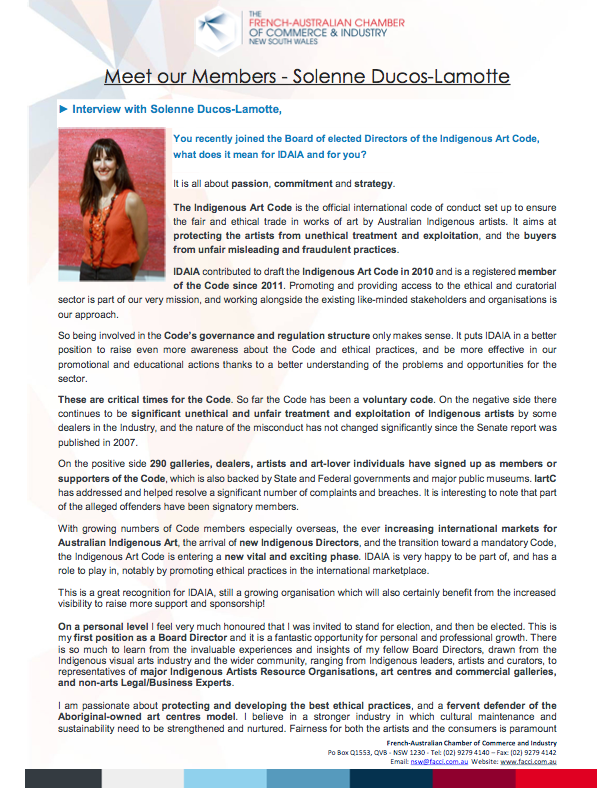In the November newsletter 2013 of the FACCI (French Australian Chamber of Commerce and Industry), Solenne Ducos-Lamotte, IDAIA’s Director and Founder, discusses the future stakes of Australian Indigenous Art in the Australian and international markets and her election as a Board Director of the Indigenous Art Code in September 2013.

Interview of Solenne Ducos-Lamotte
Thursday 7 November 2013
FACCI Newsletter and website
Transcript:
“You recently joined the Board of elected Directors of the Indigenous Art Code, what does it mean for IDAIA and for you?
It is all about passion, commitment and strategy.
The Indigenous Art Code is the official international code of conduct set up to ensure the fair and ethical trade in works of art by Australian Indigenous artists. It aims at protecting the artists from unethical treatment and exploitation, and the buyers from unfair misleading and fraudulent practices.
IDAIA contributed to draft the Indigenous Art Code in 2010 and is a registered member of the Code since 2011. Promoting and providing access to the ethical and curatorial sector is part of our very mission, and working alongside the existing like-minded stakeholders and organisations is our approach. So being involved in the Code’s governance and regulation structure only makes sense. It puts IDAIA in a better position to raise even more awareness about the Code and ethical practices, and be more effective in our promotional and educational actions thanks to a better understanding of the problems and opportunities for the sector.
(…)
According to you, what are the future stakes of the Australian Indigenous Art in the Australian and international markets?
In spite of the global economic downturn and the fact that the Australian Indigenous art (AIA) market in Australia has been declining in recent years (the auctions result is probably back to the level achieved in 2002), it remains highly positive as the international market for AIA is still booming, ever growing in Europe, and opening in Asia notably in China, with collectors diversifying and starting to buy Aboriginal art. Just this year a Chinese collector bought an entire exhibition of over 40 works! Besides in Australia the downturn is counterbalanced by the recrudescence of top quality exhibitions, prizes and festivals dedicated to Indigenous art and culture, raising the bar in terms of quality and contributing to validating and solidifying the ethical sector.
The keys for the long-term viability of the AIA market are on one side the quality and the integrity of the art works, and on the other side access to information on the importance of the provenance of the art works.
(…)
Can you describe your personal background and your role within IDAIA?
I am the Founder and Director of IDAIA – International Development for Australian Indigenous Art – based in Sydney. After my initial Business School degree (1999) and a 4-year experience in management consulting in Europe, I completed my education at the prestigious Parisian art schoolsEcole Nationale Supérieure des Beaux-Arts and GRETA des Arts-Appliqués (2003), and I gained a Master of Art Administration from Sydney’s UNSW College of Fine Arts (2005).
I was previously Head of the Aboriginal art department at Michael Reid – Caruana & Reid Fine Art in Sydney (2004-2008), working in close collaboration with Australian art market analyst and 3-gallery owner Michael Reid, and world-renown scholar Wally Caruana, who was the first senior curator of Australian Indigenous Art at the National Gallery of Australia in Canberra for over twenty years.
(…)”
[Click here to read the full interview (PDF Verion)]